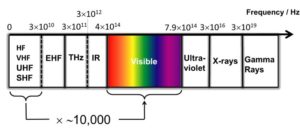To Know About This Article We Have To Know About Li-Fi
What is Li-Fi technology?
Li-Fi technology is a ground-breaking light-based communication technology, which makes use of light waves instead of radio technology to deliver data.
Li-Fi can compensate as the radio spectrum becomes overloaded

Using the visible light spectrum, Li-Fi technology can transmit data and unlock capacity which is 10,000 times greater than that available within the radio spectrum.
The visible light spectrum is plentiful, free and unlicensed, mitigating the radio frequency spectrum crunch effect.
The future internet
Li-Fi technology will in future enable faster, more reliable internet connections, even when the demand for data usage has outgrown the available supply from existing technologies such as 4G, LTE and Wi-Fi. It will not replace these technologies, but will work seamlessly alongside them.
Using light to deliver wireless internet will also allow connectivity in environments that do not currently readily support Wi-Fi, such as aircraft cabins, hospitals and hazardous environments.
Light is already used for data transmission in fibre-optic cables and for point to point links, but Li-Fi is a special and novel combination of technologies that allow it to be universally adopted for mobile ultra high speed internet communications.

Li-Fi is a communication technology which uses visible light spectrum and is also called Visible Light Communication (VLC)
Comparison of Li-Fi with Wi-Fi technology:
-> Wi-Fi uses radio spectrum whereas Li-Fi uses visible light spectrum (and some part of UV and IR spectrum)
-> Wi Fi can't penetrate into water whereas Li Fi can do with ease
-> Speed of Li Fi is 100x times faster than Wi Fi
-> Li Fi can be restricted within opaque structure (like house) but Wi Fi have access even outside opaque structure
Can it replace Wi-Fi around the world? Wi Fi is a well established technology and it can only migrate if there are cheaper technologies available. Given the huge cost involved installation needed for Li Fi and technological compliance of most of the devices, its very difficult. Moreover Li FI being based on VLC can be susceptible to interference from other daily appliances which are also based on VLC. But as the world is moving towards more efficient, high speed and eco friendly communication technology, it becomes interesting if Li Fi can be used as complementary to Wi Fi.
These Are the main Reasons"Apple's iOS code indicates Li-Fi wireless data may work on future iPhones "

Using pulses of light to transmit information, Li-Fi receivers (like a future iPhone, if Apple has its way) will take in that transmission, then translate it into an electric signal.
Because it uses light to send data, Li-Fi may be found in the connected home via accessories like light-bulbs.
Apple’s work with Li-Fi compatibility has been spotted in code for iOS 9.1, which simply notes Li-Fi capabilities. There’s no indication elsewhere that Apple is working with Li-Fi.
But, there’s indication Apple has had Li-Fi in mind for a while. AppleInsider points to a 2013 patent application for a device that sounds an awful lot like a Li-Fi transmitter.
While I’m not expecting Apple to include Li-Fi in the iPhone 7 — mainly because the technology is barely being tested in the real world — it could help push Li-Fi forward by making iPhones compatible.
Since iOS 9.1, the library cache files inside the OS mention "LiFi Capabilities" right next to other capabilities. With Li-Fi, the light from the source is received by a light sensor, which converts it into an electronic signal that is read by the phone. Don't expect Li-Fi to be offered in the Apple iPhone 7, however. The technology is still undergoing testing.
Imagine a world where your phone's internet connection comes from the technology first displayed on December 31st, 1879 by Thomas Edison. We could be just a few years away from this becoming reality.
Imagine a world where your phone's internet connection comes from the technology first displayed on December 31st, 1879 by Thomas Edison. We could be just a few years away from this becoming reality.

No comments:
Post a Comment